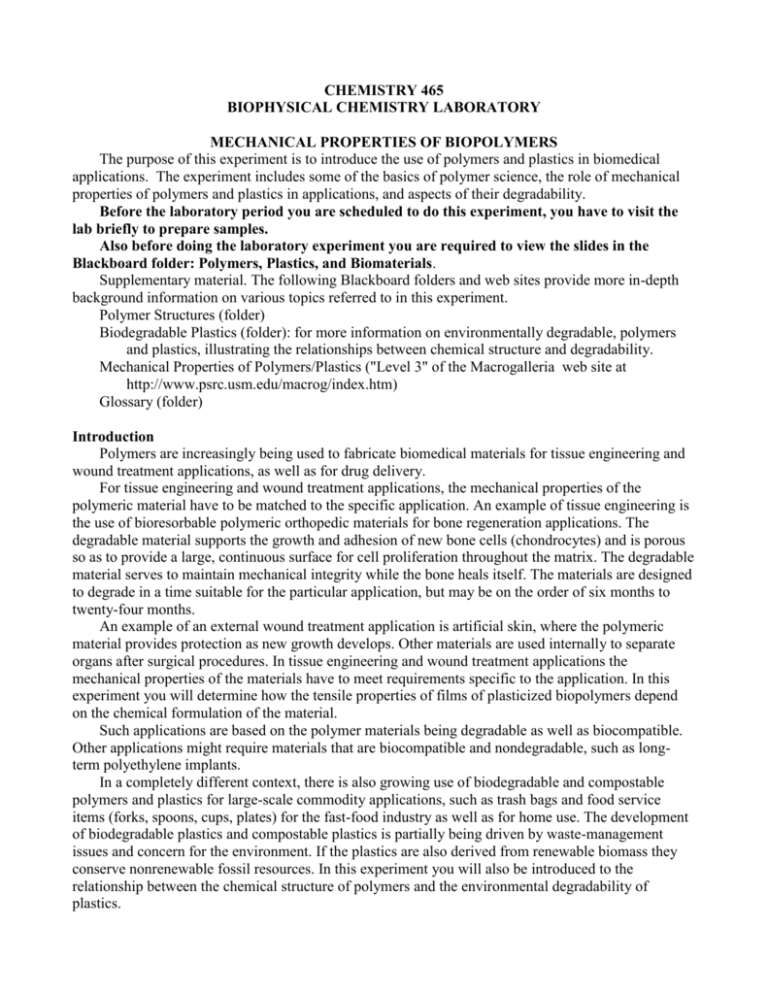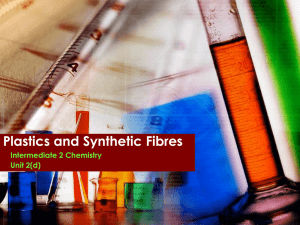Lab Manual-Mechanical Properties
advertisement

CHEMISTRY 465 BIOPHYSICAL CHEMISTRY LABORATORY MECHANICAL PROPERTIES OF BIOPOLYMERS The purpose of this experiment is to introduce the use of polymers and plastics in biomedical applications. The experiment includes some of the basics of polymer science, the role of mechanical properties of polymers and plastics in applications, and aspects of their degradability. Before the laboratory period you are scheduled to do this experiment, you have to visit the lab briefly to prepare samples. Also before doing the laboratory experiment you are required to view the slides in the Blackboard folder: Polymers, Plastics, and Biomaterials. Supplementary material. The following Blackboard folders and web sites provide more in-depth background information on various topics referred to in this experiment. Polymer Structures (folder) Biodegradable Plastics (folder): for more information on environmentally degradable, polymers and plastics, illustrating the relationships between chemical structure and degradability. Mechanical Properties of Polymers/Plastics ("Level 3" of the Macrogalleria web site at http://www.psrc.usm.edu/macrog/index.htm) Glossary (folder) Introduction Polymers are increasingly being used to fabricate biomedical materials for tissue engineering and wound treatment applications, as well as for drug delivery. For tissue engineering and wound treatment applications, the mechanical properties of the polymeric material have to be matched to the specific application. An example of tissue engineering is the use of bioresorbable polymeric orthopedic materials for bone regeneration applications. The degradable material supports the growth and adhesion of new bone cells (chondrocytes) and is porous so as to provide a large, continuous surface for cell proliferation throughout the matrix. The degradable material serves to maintain mechanical integrity while the bone heals itself. The materials are designed to degrade in a time suitable for the particular application, but may be on the order of six months to twenty-four months. An example of an external wound treatment application is artificial skin, where the polymeric material provides protection as new growth develops. Other materials are used internally to separate organs after surgical procedures. In tissue engineering and wound treatment applications the mechanical properties of the materials have to meet requirements specific to the application. In this experiment you will determine how the tensile properties of films of plasticized biopolymers depend on the chemical formulation of the material. Such applications are based on the polymer materials being degradable as well as biocompatible. Other applications might require materials that are biocompatible and nondegradable, such as longterm polyethylene implants. In a completely different context, there is also growing use of biodegradable and compostable polymers and plastics for large-scale commodity applications, such as trash bags and food service items (forks, spoons, cups, plates) for the fast-food industry as well as for home use. The development of biodegradable plastics and compostable plastics is partially being driven by waste-management issues and concern for the environment. If the plastics are also derived from renewable biomass they conserve nonrenewable fossil resources. In this experiment you will also be introduced to the relationship between the chemical structure of polymers and the environmental degradability of plastics. Polymers and Plastics Polymers can be synthetic or biological. Synthetic polymers are almost always made from nonrenewable fossil feedstocks, mainly petroleum. Examples are polyethylene, polystyrene, poly(vinyl chloride), and polypropylene, all of which are polyolefins. Poly(ethylene terephthalate) [PET] is a synthetic polyester. None of the above-named polymers are degradable, the main reason being that the polymer backbones contain only carbon-carbon single bonds. Examples of biodegradable polymers derived from petroleum are poly(vinyl alcohol) [a polyalcohol], poly(ethylene glycol)[a polyether], and the polyesters polycaprolactone and poly(glycolic acid). Polymers with heteroatoms in their backbones are generally biodegradable, although there are exceptions. Biological polymers (biopolymers) are found in nature; they are intrinsically biodegradable. Abundant biopolymers include plant polysaccharides such as starch (composed of amylose and amylopectin), cellulose, agarose, and carrageenan, and animal polysaccharides such as chitin and the glycosaminoglycans. Abundant proteins include gelatin(denatured/hydrolyzed collagen), casein, keratin, and fibroin. Microorganisms produce polyesters for storing energy and carbon. Commercial bacterial polyesters are the polyhydroxyalkanoates, including polyhydroxybutyrate, polyhydroxyvalerate, and the copolymer poly(hydroxybutyrate-co-valerate). They are produced by fermentation; the particular polyester produced depends on the microbial strain being used and the growth substrate. Poly(lactic acid) (PLA) is an example of a synthetic commercial polymer in which the monomer, lactic acid, is produced in large amounts through fermentation; the polymer is then synthesized by conventional methods. PLA is biodegradable. A plastic is a material that contains one or more organic polymeric substance of large molecular weight. Plastics almost always also contain additives that give the plastic desirable properties, such as plasticizers that act as softening agents. The bulk polymeric material, called resin, is processed to produce three-dimensional shapes or films. Examples of common engineering processes, in addition to various molding methods, are extrusion and film casting. Plastics are of two types. Ninety percent of plastics are thermoplastics, which can be repeatedly softened; their polymer chains are generally linear or only slightly branched. Thermosets cannot be reworked after curing; their chains are highly cross-linked in the curing process. An example is epoxy resin. Polymers can also be processed to form coatings (including paints), elastomers (various rubbers), or fibers, all of which are technically distinguished from plastics. Mechanical Properties Plastics are formulated and processed to produce properties appropriate for the intended application. Test methods for measuring plastics properties are standardized to produce uniformity within the plastics industry. In the United States, standardization of test methods is the responsibility of the American Society for Testing and Materials (ASTM). Over 500 test methods have been developed for plastics alone, covering a wide range of properties. In this experiment you will use a protocol based on ASTM Standard Test Method D 882 for Tensile Properties of Thin Plastic Sheeting. In implant and wound healing applications, the mechanical properties of the materials are of critical importance. In this experiment you will carry out tensile tests—tests in which specimens are placed between two clamps (grips) and drawn. The instrument measures and displays the force being applied (the load) and the resulting increase in the length of the sample (elongation, also called extension). 2 From the dimensions of the film specimen (width and thickness), the instrument software calculates and displays the tensile stress (), equal to the load (F) per unit area of cross section (A = width x thickness). It also calculates the (tensile) strain (), equal to the elongation (extension) divided by the original length of that portion of the specimen being measured (called the gage length). [In our experiment, the gage length is simply the separation of the grips securing the specimen.] The instrument will display percent elongation, which is the strain multiplied by 100. As the tensile test proceeds, the instrument generates and displays a tensile stress-strain curve, which is a diagram that displays values of tensile stress (in MPa) plotted against tensile strain (%). The test continues until the specimen breaks. From the stress-strain curve, the software determines, and reports the following results in table form: (1) tensile strength at break (or ultimate strength), which is the tensile stress at break. (2) elongation at break, as a percentage. (3) Young's modulus (also known as elastic modulus or modulus of elasticity or sometimes simply as modulus). It is calculated as the initial slope of the stress-strain curve, which is usually observed to be linear with plastic films. This initial region reflects the elastic deformation of the specimen, in which the stress varies linearly with strain, analogous to Hooke's law for the expansion of a spring. Beyond the linear region, the behavior is termed viscous; polymers and plastics are said to be viscoelastic materials. Modulus is a measure of the "stiffness" of the polymer or plastic. Table 1. Typical tensile properties of materials Material t.s.(MPa) elong.(%) modulus(MPa) polyethylene, low density 10 620 166 polycaprolactone 26 600-1000 435 polypropylene 36 1380 poly(lactic acid), 110/145 160/100 3310/3860 biaxially oriented film keratin(human hair) 526 46 6700 copper, annealed 240 30 100,000-130,000 steel 380-700 200,000-250,000 glass 2160-4830 50,000-70,000 Encyclopedia of Chemistry, 4th ed.; Handbook of Physics, 2nd ed. 3 Experimental Procedure - Prior to the Scheduled Laboratory Period Visit 1. Film casting Prepare the following cast films of plasticized biopolymers. Sample 1. Place 32 mL of 2%(v/v) aqueous glycerol solution in a 200 mL beaker. Add 88 mL water and 3.20 g agar. Heat with stirring to approximately 85-95 °C or until the polymer is in solution; do not boil. Slowly pour the solution into the drying pan on a flat level surface. Try to remove all imperfections (bubbles) from the surface. Sample 2. Repeat using 64 mL glycerol solution, 56 mL water, and 2.40 g agar. Sample 3. Repeat using 80 mL glycerol solution, 40 mL water, and 2.00 g agar. Sample 4. Repeat using 64 mL glycerol solution, 56 mL water, 1.20 g agar, and 1.20 g starch. Allow the solutions to set for approximately one hour then place the pans in the drying oven. Label all drying pans. Visit 2. Film conditioning After the agar films have been in the drying oven for about 24 hours, remove the pans from the oven and place them in the large relative-humidity conditioning box (maintained at approximately 50% relative humidity) for 24-48 hours. Visit 3. Preparing test specimens After conditioning, the films are ready to have test specimens prepared from them. Working with one sample at a time, remove the pan from the conditioning box. Slowly and carefully remove the film from the pan by first peeling one corner and then applying fairly equal pressure to the entire width of the film as it comes off the pan lengthwise. Place the sample on a piece of cardboard. Using the 1/4" wide aluminum template as a straight edge, and the cutting knife, cut a rectangle approximately 3.5" x 3" from the center of the film, so as not to include any edges, as they are often not as uniform in thickness as the center. Align the sample on the cardboard as follows: Place the 1/4" wide aluminum template vertically near one of the edges. Using the cutting tool, cut on both sides of the template to produce a specimen 3.5" long and 1/4" wide. Cut as cleanly as possible so as not to notch or tear the specimen. Cut six or seven additional strips, but do not use the second cut of the previous specimen as the first edge of the next; make two new cuts to produce each specimen. Place the cut specimens on a piece of filter paper and transfer them into the electronic dessicator located next to the Instron instrument. Similarly prepare specimens from the other three film samples. 4 Experimental Procedure – During the Scheduled Laboratory Period During the laboratory you will measure the mechanical properties of the fours cast films. Measure at least five specimens for each of the four film samples. As you remove each specimen from the electronic dessicator, you will be measuring the thickness of the specimen with a micrometer. If you are not familiar with using a micrometer, or reading a vernier scale, your instructor will show you. Operating the Instron Testing Instrument 1. Before turning anything on, locate the following features on the test column. Emergency Stop Switch (large red knob on lower right of test column; used to stop test quickly, when safety is compromised) Main Power Switch (rear right) Jog Up, Jog Down, and Fine Position (moves the crosshead up and down). You will not have to operate this control. Upper Limit Stop, Lower Limit Stop (yellow with black knobs, on right of column, they limit the crosshead movement) Reset GL (Gauge Length) (controls the Return response) Standby, Ready Start, Stop, Return (These operations are usually controlled with the software.) Locate the interface box, to the left of the test column. 2. Start up and Check. Turn on the printer (check paper supply). Turn on Main Power Switch. Monitor the Self-Test sequence on the interface box. It should count down to 2 then stop. Check that the crosshead travel limit stops are in place. Turn on the monitor and computer. Double click on the Merlin icon when it appears. Click on the name of the test method: Film-0.25in. Wait. The Merlin Screen will appear. Click on Load Frame icon (to the right of the live digital displays). Check that "Below crosshead" is on. Click Done. Click on Extension icon (upper right corner). Press Reset Gauge Length (digital reading will go to zero). Click Done. Click on the Load Cell icon (to the left of the Extension icon). Select Automatic, then Calibrate. At "Remove Load from Load Cell" click OK. Wait. When complete, click Done. 3. Running the sample. As you prepare to test each specimen, measure the film thickness to 0.0001", using the micrometer. Check "Pretest Sample" settings: Speed 2 in/min, number of specimens in sample (enter the number of specimens of that film that you have prepared), assign your sample a name, enter an operator ID, enter the temperature and humidity, assign a specimen name, width (0.25 in), thickness (as measured), length (2 in.) [Note. This is the gage length (separation of grips), not the full length of the film.] When OK click Continue. [Throughout the testing, a message will appear: "You have not 5 accepted every field…" Check that the fields are correct then click Yes.] Check "Specimen" settings. Change Specimen name as desired. If OK click Start Test. Follow the instructions, "Install the specimen, then click OK", as follows: The sample should hang vertically. There should be no significant slack, although the film will not be perfectly taut. The tensile strength digital display may not read zero, but should not be significantly large. When the specimen is installed, click OK. During the test, if the graph goes off scale, click the Rescale Icon on the graph screen, to the left of the printer icon. At specimen break, follow instructions to remove the specimen and click OK to return the crosshead. Check that the specimen is entirely removed from the grips. After each test, the used specimen may be discarded. For additional specimens, click Continue on Test Director. Add Comment on previous specimen test if desired; it is not necessary. Then click Continue. Change Specimen Name as desired. Measure the thickness and enter. Click Start Test. After the last specimen has been run, and the results have appeared in the Results table, print the report. 4. Printing the Report. Click on the Report icon (bottom icon on right of screen). The Report screen will open to the report template. Click on Printer icon, on right of Report tool bar. 5. End Testing. Click End Sample, enter a comment if desired, then Continue. Enter a Note if desired, then Continue. Save as: (Name as desired but save the file in the CHEM 465 directory.) Then choose either: (A) Start New Sample, to run the specimens of your next film. If you have just printed a report, the report screen will be showing when you start your next run. Click the graph icon, just above the report icon, to get the graph screen. or (after the last film sample) (B) Start New Sample, then Save Method (from File), then Exit (from File) Close Test Director. 6 6. Shut down. Click Start/Turn off computer/Turn Off. When the computer shuts down, turn off the monitor. Turn off printer and testing instrument. Laboratory Report 1. Express the compositions of the four film samples in terms of the weight percent of each component to two significant figures (excluding water); i.e. % agar, % glycerol (the density of glycerol is 1.26) and, if present, % starch. 2. Prepare a summary table of results showing the mean values of tensile strength (Mpa) (to 3 sig. figs.) and its standard deviation, elongation (%) (to 2 sig. figs.) and its standard deviation, and elastic modulus (MPa) (to 3 sig.figs.) and its standard deviation. [ASTM specifies these numbers of significant figures; a smaller number of significant figures would otherwise be justified given the observed standard deviations.] 3. For the three agar-glycerol films what correlation do you observe between the effect of glycerol on one property and its effect on the others? Prepare a graph for each of the properties showing variation with composition. In Excel you can show a standard error for each point separately by using a separate data series for each point. Do not show a trend line and do not attempt to connect the data points. 4. What is the effect of replacing some of the agar with starch? Acknowledgments. This experiment was developed with the assistance of undergraduates Kyle Baumstein and James-Michael Leahy. 7




